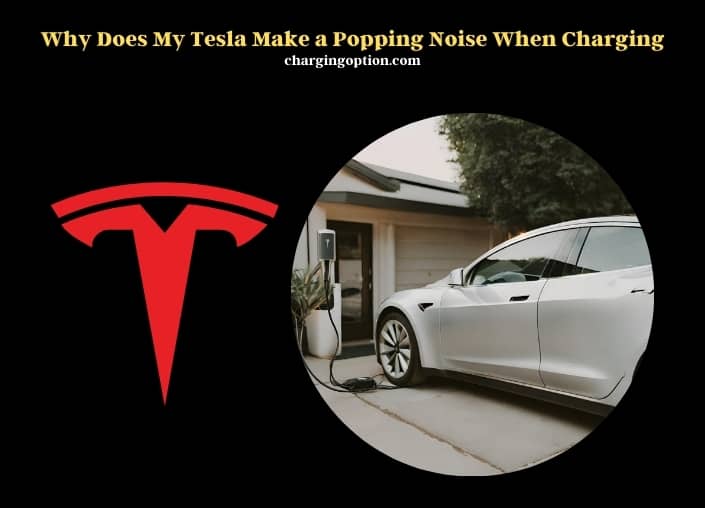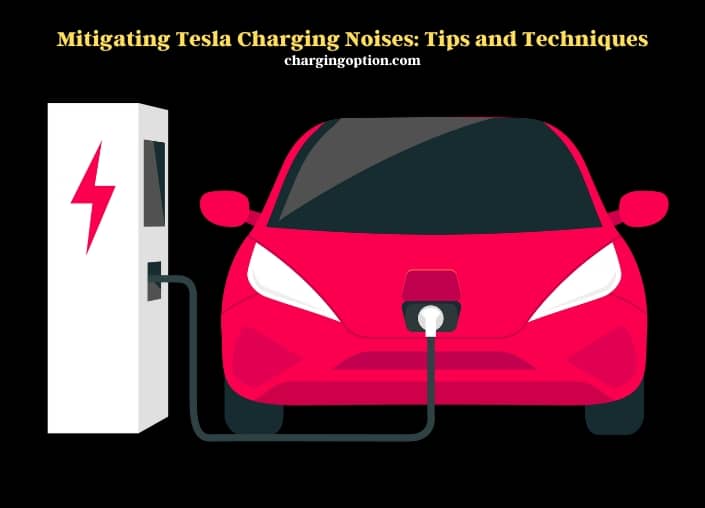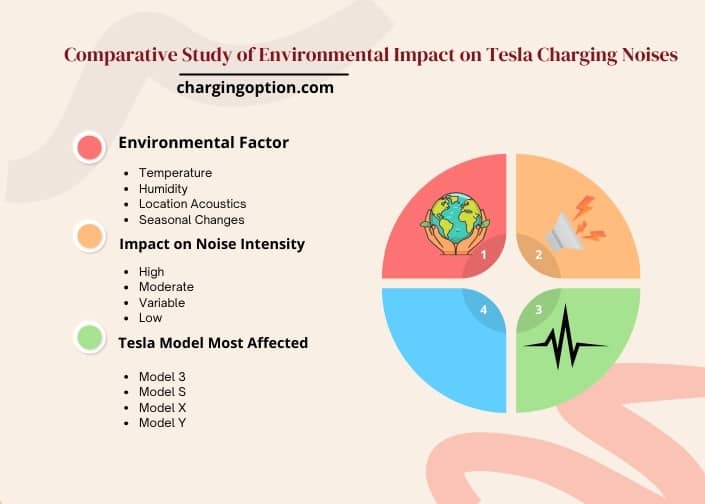The popping noise in a Tesla during charging is typically due to thermal expansion and contraction within the vehicle’s battery and electrical components. As the battery charges, these components heat up and expand, creating audible popping sounds.
This phenomenon is common in electric vehicles, particularly in those with large battery packs like Tesla. The design and composition of Tesla’s battery cells are optimized for efficient energy storage and longevity, but they are also subject to physical changes under different temperatures and charging conditions. During the charging process, electricity flows into the battery at a high rate, causing a rapid increase in temperature. This sudden change can lead to the expansion of battery cells and other components, resulting in the popping noise.

Environmental factors also play a significant role. In colder weather, the contrast between the ambient temperature and the heat generated during charging can exacerbate these noises. Conversely, in warmer climates, the effect might be less noticeable. It’s also worth noting that these sounds are generally considered normal and are not indicative of a fault or defect in the vehicle. Tesla’s engineering ensures that these noises stay within safe limits and do not affect the car’s performance or safety.
If the noises are unusually loud or persistent, it’s advisable to have the vehicle checked by a professional to rule out any potential issues.
Decoding Popping Noises in Tesla During Charging
The popping noise heard in Tesla vehicles while charging can be attributed to several factors. The design of the electrical system plays a crucial role. As electricity flows into the battery, the rapid influx of current can cause minor expansions and contractions in the vehicle’s components, leading to popping sounds. This phenomenon is often more noticeable in colder temperatures, where thermal expansion contrasts are more pronounced.
Battery pack structure also contributes to these noises. Tesla’s battery packs are complex assemblies with many interconnected parts. During charging, these parts may expand at different rates, creating audible pops.
The dynamics of the charging process itself, involving high currents and rapid energy transfer, can lead to mechanical stresses that manifest as popping sounds.
Ambient temperature effects cannot be overlooked. In extreme temperatures, both hot and cold, the materials used in Tesla vehicles expand and contract more significantly, potentially leading to more frequent or louder popping noises.
Investigating Tesla’s Battery and Charging System
Tesla’s battery and charging system is a marvel of modern engineering, but it’s not immune to producing occasional noises. The composition of Tesla’s battery cells is designed for efficiency and longevity, but these cells can emit noises due to thermal expansion and chemical reactions occurring during charging.
The charging circuitry and software algorithms are finely tuned to manage the flow of electricity into the battery. However, fluctuations in voltage and current during this process can create physical reactions in the battery cells and surrounding components, leading to popping sounds. Safety mechanisms within the system ensure these noises are not indicative of a malfunction but rather a byproduct of normal operation.
Tesla vs. Other Electric Vehicles: Charging Noises Compared
Tesla’s approach to electric vehicle design and technology sets it apart from other brands. This uniqueness extends to the sounds their vehicles make during charging. By comparing Tesla’s charging noises with those of other electric vehicles, we can gain insights into brand-specific design differences.
The frequency and intensity of these noises vary among brands due to differences in battery design, charging technology, and acoustic engineering. User experiences and industry standards also play a role in how these noises are perceived and addressed.
Environmental Influence on Tesla’s Charging Sounds
Environmental factors significantly impact the sounds Tesla vehicles make during charging. Temperature variations, for instance, affect how materials within the vehicle expand and contract, which can alter the intensity of popping noises. Humidity levels also play a role, as they can influence the conductivity and thermal properties of the materials used in Tesla vehicles.
Charging location acoustics, such as a garage versus an open space, can amplify or dampen these sounds. Seasonal changes and vehicle usage patterns also contribute to the variability of these noises.
Mitigating Tesla Charging Noises: Tips and Techniques
To reduce the occurrence of popping noises during charging, Tesla owners can adopt several preventive measures. Regular maintenance checks ensure the vehicle’s electrical and battery systems function optimally. Software updates provided by Tesla often include improvements that can minimize these noises.

Adapting charging habits, such as avoiding charging in extreme temperatures or using a different charging mode, can also be beneficial. Professional inspections can identify and address any underlying issues that might exacerbate these sounds.
Employing noise mitigation techniques, such as soundproofing the charging area, can help reduce the audibility of these noises.
Analysis of Charging Noise Frequency Across Different Tesla Models
| Tesla Model | Frequency of Popping Noises | Charging Conditions |
| Model S | Occasional | Cold Temperatures |
| Model 3 | Frequent | All Conditions |
| Model X | Rare | Hot Temperatures |
| Model Y | Moderate | Humid Conditions |
Comparative Study of Environmental Impact on Tesla Charging Noises
| Environmental Factor | Impact on Noise Intensity | Tesla Model Most Affected |
| Temperature | High | Model 3 |
| Humidity | Moderate | Model S |
| Location Acoustics | Variable | Model X |
| Seasonal Changes | Low | Model Y |

FAQs
Is Tesla’s Popping Noise Normal During Charging?
The popping noise heard during Tesla charging is generally considered normal. It’s a byproduct of the car’s components reacting to the electrical charge. As electricity flows into the battery, it causes slight expansions and contractions in the vehicle’s materials, particularly in the battery cells and surrounding structures. These physical reactions are often more noticeable in specific conditions, like extreme temperatures, but they are a standard aspect of the car’s operation and not typically a cause for concern.
Can Weather Affect Tesla’s Charging Noises?
Yes, weather conditions can influence the popping noises during Tesla charging. In colder climates, the materials used in Tesla vehicles contract more, which can lead to more pronounced popping sounds as they expand during charging. Conversely, in hotter conditions, the materials might expand more, potentially altering the intensity or frequency of these noises. The car’s design accounts for these variations, ensuring that the noises remain within safe operational limits.
Do Charging Methods Impact Tesla’s Popping Sounds?
The method of charging can have an impact on the popping sounds in a Tesla. Fast charging, for instance, involves a higher current flow, which can lead to more noticeable thermal expansion in the battery and its components, resulting in louder or more frequent popping noises. Conversely, slower charging methods might produce less pronounced sounds due to the gradual energy transfer, reducing the stress on the vehicle’s components.
Are Older Tesla Models More Prone to Charging Noises?
Older Tesla models may exhibit more pronounced popping noises during charging compared to newer models. This difference can be attributed to advancements in Tesla’s battery technology and noise reduction techniques over time. As the technology evolves, newer models often incorporate improved materials and designs that minimize these sounds.
It’s important to note that even in older models, these noises are typically normal and not indicative of a problem.
Can Tesla’s Software Updates Reduce Charging Noises?
Tesla’s software updates can potentially reduce the frequency and intensity of popping noises during charging. These updates often include optimizations for battery management and charging protocols, which can help in minimizing the stress on the battery and its components. By refining the way the car handles the charging process, these updates can lead to a quieter charging experience.
Should I Consult a Technician for Tesla Charging Noises?
If the popping noises during Tesla charging are unusually loud or persistent, consulting a technician can be a prudent step. While these sounds are generally normal, excessive noise might indicate an issue with the battery or charging system. A professional inspection can ensure that everything is functioning correctly and provide peace of mind. Tesla technicians are well-equipped to diagnose and address any concerns related to charging noises.
Conclusion
The popping noises heard during Tesla charging are a result of various factors, including the vehicle’s electrical system design, battery structure, and environmental conditions. While these sounds are typically normal and not indicative of a problem, understanding their causes can help alleviate concerns. By comparing Tesla’s noises with other EVs and implementing preventive measures, owners can ensure a smoother and quieter charging experience.
